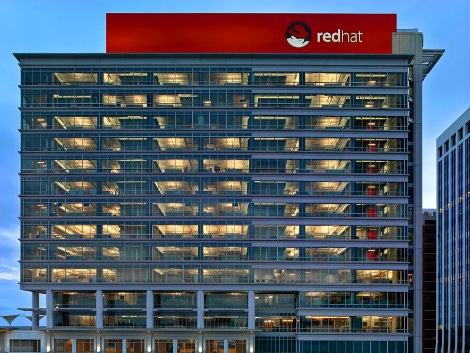IBM Closes $34 Billion Red Hat Acquisition in Cloud Catch-UpIBM Closes $34 Billion Red Hat Acquisition in Cloud Catch-Up
IBM closed its $34 billion purchase of Red Hat, sealing the world’s second-largest technology deal ever and setting up the iconic U.S. company on a path to try to compete with top software purveyors in the cloud.
July 9, 2019

(Bloomberg) -- IBM closed its $34 billion purchase of Red Hat, sealing the world’s second-largest technology deal ever and setting up the iconic U.S. company on a path to try to compete with top software purveyors in the cloud.
The 108-year-old International Business Machines Corp., once synonymous with mainframe computing, has been struggling to adopt cloud-related technologies. It’s playing catch-up to market leaders Amazon.com Inc. and Microsoft Corp. in offering computing and other software and services over the internet.
For Chief Executive Officer Ginni Rometty, who has staked her legacy on the deal designed to save the company from irrelevancy, it is a defining moment.
"This is about hybrid cloud -- it is the future, it is the destination of the cloud," Rometty said in an interview. "This market is a trillion dollars, it’s emerging and it’s very interesting to me that since our announcement now you hear everybody else talking about it too."
Having already fallen behind in the public cloud, IBM is betting big on the so-called hybrid cloud, which allows companies to simultaneously run programs on both their own internal servers and the big public cloud providers, Amazon Web Services and Microsoft’s Azure. In positioning IBM as a partner for those companies, rather than a competitor, Rometty is taking a page out of the playbook of Lou Gerstner.
The former IBM CEO, who directed Big Blue to join with software developers to ensure their applications could run smoothly on IBM’s hardware instead of battling against them, was lauded for saving IBM from bankruptcy in the 1990s.
IBM has reported shrinking revenue for six out of the past seven years and its new hybrid cloud strategy could help boost growth, according to Bloomberg Intelligence analyst Anurag Rana.
"What stood out to us was that IBM would be working closely to its main rivals, Amazon, Microsoft, Google and Alibaba," Rana said. "This shows a mature way of thinking about the competitive landscape, and if IBM remains true to this philosophy, it should show an improvement in growth down the road."
Through Red Hat, IBM will offer clients the chance to merge their private and public clouds -- regardless of which provider they use. “Today people have five to 15 different public clouds and move data between them,” Rometty said. "The platform we are talking about has to run on other people’s clouds too." IBM will offer the first hybrid multi-cloud platform, providing the glue to connect various clouds together. “You’ll hear others say hybrid cloud and then only connect their public to their private clouds. Well that’s not that helpful for a client. It has to be multi-cloud,” Rometty said.
IBM paid $190 a share for Red Hat in cash, for a total equity value of about $34 billion, the company said in a statement Tuesday. The deal was announced in October. IBM shares were little changed at $139.90 in New York. They have gained about 12% since the deal was announced.
IBM’s cloud revenue has grown to 25% of total revenue now, from 4% in 2013, the Armonk, New York-based company said. In the 12 months through the first quarter of this year, IBM cloud revenue grew to more than $19 billion. The Red Hat acquisition is expected to contribute about 2 points of compound annual revenue growth to IBM over a five-year period, the company said.
Red Hat’s open hybrid cloud technologies will be matched with IBM’s industry expertise and sales teams in more than 175 countries, IBM said. The combined group will be able to offer a “next-generation hybrid multicloud platform,” based on open source technologies such as Linux and Kubernetes. The platform will allow companies to run and manage their data and applications both on-site and on private and multiple public clouds.
IBM mostly missed the public-cloud revolution under Rometty’s predecessor, Sam Palmisano, who dismissed Amazon’s strategy of spending heavily on massive data centers to handle other companies’ computing tasks. Rometty tried to break into the market with the $2 billion acquisition of SoftLayer Technologies Inc. in 2013, but by then Amazon, Microsoft Corp. and even Google already had a head start.
"From a strategic point of view, we think the acquisition will position IBM as a formidable player in the hybrid IT market," Evercore ISI analyst Amit Daryanani wrote in a note to investors Tuesday.
The difficulty in the deal is whether Red Hat’s open source developer community can successfully integrate into IBM, which has a deeply entrenched corporate culture. In order to streamline the transition, Red Hat will maintain its headquarters in Raleigh, North Carolina, and the company will be run as a distinct unit within IBM, controlling their own sales unit, contracting and terms and conditions. Red Hat CEO Jim Whitehurst and the wider leadership team "are all staying with us for a good long time," Rometty said. "I very much want Microsoft and everyone very comfortable that they will get the same access as we get on that technology because that’s critical for our customers that the same platform be able to run everywhere," she said.
About the Author
You May Also Like






.jpg?width=700&auto=webp&quality=80&disable=upscale)
